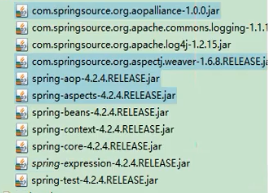1.Spring管理事务配置案例:
方式1:编码式(了解):
1.将核心事务管理器配置到spring容器,在applicationContext中配置如下代码:
<!-- 事务核心管理器,封装了所有事务操作. 依赖于连接池 --> <bean name="transactionManager" class="org.springframework.jdbc.datasource.DataSourceTransactionManager"> <property name="dataSource" ref="dataSource"></property> </bean>
2.配置TransactionTemplate模板,在applicationContext中配置如下代码:
<!--事务模板对象--> <bean class="org.springframework.transaction.support.TransactionTemplate"> <property name="transactionManager" ref="transactionManager"></property> </bean>
3.将事务模板注入Service
<!-- 3.Service--> <bean name="accountService" class="com.yyb.service.AccountServiceImpl"> <property name="ad" ref="accountDao"></property> <property name="tt" ref="transactionTemplate"></property> </bean>
4.在Service中调用模板
package com.yyb.service;
import com.yyb.dao.AccountDao;
import org.springframework.transaction.TransactionStatus;
import org.springframework.transaction.support.TransactionCallbackWithoutResult;
import org.springframework.transaction.support.TransactionTemplate;
public class AccountServiceImpl implements AccountService {
private AccountDao ad;
private TransactionTemplate tt;
//匿名内部类访问外部变量得加final
@Override
public void transfer(final Integer from,final Integer to, Double money) {
tt.execute(new TransactionCallbackWithoutResult() {
@Override
protected void doInTransactionWithoutResult(TransactionStatus transactionStatus) {
//减钱
ad.decreaseMoney(from,money);
//int i=1/0;
//加钱
ad.increaseMoney(to,money);
}
});
}
public void setAd(AccountDao ad) {
this.ad = ad;
}
public void setTt(TransactionTemplate tt) {
this.tt = tt;
}
}
方式2:xml配置(aop)
简单理解就是把通知织入到目标对象中,形成一个代理对象。比如通知要进行事务管理,目标对象要进行业务处理。那么代理对象则把事务管理和业务处理合到了一起。SpringAOP给我们准备了一个事务通知,目标对象即我们的service。所以只需要配置一下就可以了。
1、需要导包aop、aspect、aop联盟、weaving织入包

2.导入新的约束(tx)

beans: 最基本约束;context:读取properties配置约束;aop:配置aop约束;tx:配置事务通知约束
3.配置通知和配置将通知织入目标:
<?xml version="1.0" encoding="UTF-8"?> <beans xmlns="http://www.springframework.org/schema/beans" xmlns:xsi="http://www.w3.org/2001/XMLSchema-instance" xmlns:aop="http://www.springframework.org/schema/aop" xmlns:context="http://www.springframework.org/schema/context" xmlns:tx="http://www.springframework.org/schema/tx" xsi:schemaLocation="http://www.springframework.org/schema/beans http://www.springframework.org/schema/beans/spring-beans.xsd http://www.springframework.org/schema/aop http://www.springframework.org/schema/aop/spring-aop.xsd http://www.springframework.org/schema/context http://www.springframework.org/schema/context/spring-context.xsd http://www.springframework.org/schema/tx http://www.springframework.org/schema/tx/spring-tx.xsd"> <!-- 指定spring读取db.properties配置 --> <context:property-placeholder location="classpath:db.properties" /> <!-- 1.将连接池放入spring容器 --> <bean name="dataSource" class="com.mchange.v2.c3p0.ComboPooledDataSource" > <property name="jdbcUrl" value="${jdbc.jdbcUrl}" ></property> <property name="driverClass" value="${jdbc.driverClass}" ></property> <property name="user" value="${jdbc.user}" ></property> <property name="password" value="${jdbc.password}" ></property> </bean> <!--2.将JDBCTemplate放入spring容器--> <!--<bean name="jdbcTemplate" class="org.springframework.jdbc.core.JdbcTemplate" >--> <!--<property name="dataSource" ref="dataSource" ></property>--> <!--</bean>--> <!-- 3.将UserDao放入spring容器 --> <bean name="userDao" class="cn.itcast.a_jdbctemplate.UserDaoImpl" > <!-- <property name="jt" ref="jdbcTemplate" ></property> --> <!-- 如果 UserDaoImpl继承了JdbcDaoSupport,就不需要在生产一个dataSource的bean--> <property name="dataSource" ref="dataSource" ></property> </bean> <!-- 2.Dao--> <bean name="accountDao" class="com.yyb.dao.AccountDaoImpl"> <property name="dataSource" ref="dataSource"></property> </bean> <!-- 3.Service--> <bean name="accountService" class="com.yyb.service.AccountServiceImpl"> <property name="ad" ref="accountDao"></property> </bean> <!-- 事务核心管理器,封装了所有事务操作. 依赖于连接池 --> <bean name="transactionManager" class="org.springframework.jdbc.datasource.DataSourceTransactionManager"> <property name="dataSource" ref="dataSource"></property> </bean> <!-- 配置事务通知 --> <tx:advice id="txAdvice" transaction-manager="transactionManager" > <tx:attributes> <!-- 以方法为单位,指定方法应用什么事务属性:isolation:隔离级别 propagation:传播行为 read-only:是否只读--> <tx:method name="transfer" isolation="DEFAULT" propagation="REQUIRED" read-only="false"/> <!--上面的方式只适用单个方法,当我们业务有很多个方法都要操作事务时,则要配置很多个,可以使用下面的通配符配置方式--> <tx:method name="save*" isolation="REPEATABLE_READ" propagation="REQUIRED" read-only="false" /> <tx:method name="persist*" isolation="REPEATABLE_READ" propagation="REQUIRED" read-only="false" /> <tx:method name="update*" isolation="REPEATABLE_READ" propagation="REQUIRED" read-only="false" /> <tx:method name="modify*" isolation="REPEATABLE_READ" propagation="REQUIRED" read-only="false" /> <tx:method name="delete*" isolation="REPEATABLE_READ" propagation="REQUIRED" read-only="false" /> <tx:method name="remove*" isolation="REPEATABLE_READ" propagation="REQUIRED" read-only="false" /> <tx:method name="get*" isolation="REPEATABLE_READ" propagation="REQUIRED" read-only="true" /> <tx:method name="find*" isolation="REPEATABLE_READ" propagation="REQUIRED" read-only="true" /> </tx:attributes> </tx:advice> <!--配置织入--> <aop:config> <aop:pointcut id="txPc" expression="execution(* com.yyb.service..*(..))"/> <!--配置切面--> <aop:advisor pointcut-ref="txPc" advice-ref="txAdvice" /> </aop:config> <!-- 开启事务注解驱动--> <tx:annotation-driven transaction-manager="transactionManager" /> </beans>
方式3:注解配置(aop):
1.导包(同上)
2.导入新的约束(tx),同上
3.开启注解管理事务
<?xml version="1.0" encoding="UTF-8"?>
<beans xmlns:xsi="http://www.w3.org/2001/XMLSchema-instance" xmlns="http://www.springframework.org/schema/beans"
xmlns:context="http://www.springframework.org/schema/context"
xmlns:aop="http://www.springframework.org/schema/aop" xmlns:tx="http://www.springframework.org/schema/tx"
xsi:schemaLocation="http://www.springframework.org/schema/beans http://www.springframework.org/schema/beans/spring-beans-4.2.xsd http://www.springframework.org/schema/context http://www.springframework.org/schema/context/spring-context-4.2.xsd http://www.springframework.org/schema/aop http://www.springframework.org/schema/aop/spring-aop-4.2.xsd http://www.springframework.org/schema/tx http://www.springframework.org/schema/tx/spring-tx-4.2.xsd ">
<!-- 指定spring读取db.properties配置 -->
<context:property-placeholder location="classpath:db.properties"/>
<!-- 事务核心管理器,封装了所有事务操作. 依赖于连接池 -->
<bean name="transactionManager" class="org.springframework.jdbc.datasource.DataSourceTransactionManager">
<property name="dataSource" ref="dataSource"></property>
</bean>
<!--开启使用注解管理aop事务-->
<tx:annotation-driven/>
<!-- 1.连接池 -->
<bean name="dataSource" class="com.mchange.v2.c3p0.ComboPooledDataSource">
<property name="jdbcUrl" value="${jdbc.jdbcUrl}"></property>
<property name="driverClass" value="${jdbc.driverClass}"></property>
<property name="user" value="${jdbc.user}"></property>
<property name="password" value="${jdbc.password}"></property>
</bean>
<!-- 2.Dao-->
<bean name="accountDao" class="com.yyb.dao.AccountDaoImpl">
<property name="dataSource" ref="dataSource"></property>
</bean>
<!-- 3.Service-->
<bean name="accountService" class="com.yyb.service.AccountServiceImpl">
<property name="ad" ref="accountDao"></property>
</bean>
</beans>
4.使用注解
@Transactional(isolation = Isolation.REPEATABLE_READ,propagation = Propagation.REQUIRED,readOnly = false)
public void transfer(Integer from,Integer to, Double money) {
在方法上加注解,如果方法太多,嫌麻烦的话,可以在类上加,如果某个方法不适应,再在方法上写一份即可。
package com.yyb.service;
import com.yyb.dao.AccountDao;
import org.springframework.transaction.annotation.Isolation;
import org.springframework.transaction.annotation.Propagation;
import org.springframework.transaction.annotation.Transactional;
@Transactional(isolation = Isolation.REPEATABLE_READ,propagation = Propagation.REQUIRED,readOnly = false)
public class AccountServiceImpl implements AccountService {
private AccountDao ad;
@Override
@Transactional(isolation = Isolation.DEFAULT,propagation = Propagation.REQUIRED,readOnly = false)
public void transfer(Integer from,Integer to, Double money) {
//减钱
ad.decreaseMoney(from,money);
//int i=1/0;
//加钱
ad.increaseMoney(to,money);
}
public void setAd(AccountDao ad) {
this.ad = ad;
}
}
